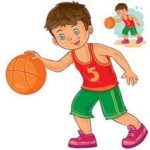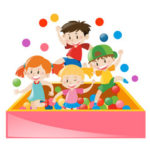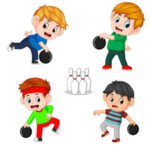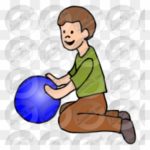
by Santosh | Jun 25, 2020 | Soccer, Sports
LEARNING OUTCOME
To improve accuracy and weight of pass and control / 1st touch
TEACHING CUES
- Awareness of the position of the target ball
- Emphasis on controlling the ball and getting your shot at the target ball off as quickly as possible
- Awareness of on coming balls that have missed the target ball
- Passing techniques, side foot or strike with laces
ACTIVITY SET-UP AND PROCEDURE
EQUIPMENT:
Marked area, balls.
SET-UP:

ACTIVITY PROCEDURES:
- Mark off an area of suitable size for the number and age of players.
- The group is split in to 2 teams, each team lines up on opposite sides of the area.
- One target ball is placed in the middle of the area and each team has 2 or 3 balls as ammunition.
- The aim of the game is to knock the target ball over the opposition’s goal line.
- Both teams can fire at the same time.
Progressions:
- Make the areas smaller or larger
- Add more than one target ball
- Players on 2 touch, one to control, one to strike
- Players must pass before shooting at the target ball
COOL DOWN/ CLOSURE
Review Skill/Activity, stretching, and questions.
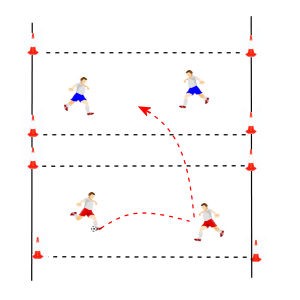
by Santosh | Jun 24, 2020 | Soccer, Sports
LEARNING OUTCOME
To improve control, heading and volleying techniques
TEACHING CUES
- Emphasis is on 1st touch, soft touch, keep ball out of feet and in the direction of supporting player
- Players encouraged to keep the ball in the air which will allow team mate an easier pass to deal with before knocking over the net.
- Communication is essential
ACTIVITY SET-UP AND PROCEDURE
EQUIPMENT:
Marked area appropriate size for age, 8 cones, 1 ball between 4 players
SET-UP:

ACTIVITY PROCEDURES:
- Using the scoring system from tennis, players pass, volley or head the ball to the opponent’s side of the court / area over the net (or coned area).
- Each team are allowed three touches and 2 bounces before knocking the ball over the net.
Progressions:
- Allow more or less touches and bounces
- Increase / decrease the size of the area
COOL DOWN/ CLOSURE
Review Skill/Activity, stretching, and questions.
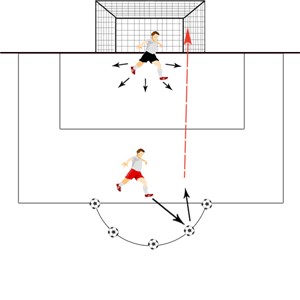
by Santosh | Jun 24, 2020 | Soccer, Sports
LEARNING OUTCOME
To improve Goalkeeping techniques
TEACHING CUES
- Keeper to be on toes all the time
- Anticipation & awareness
- Footwork – agility & flexibility
- Starting position
- Saving technique
ACTIVITY SET-UP AND PROCEDURE
EQUIPMENT:
Marked area, cones and balls
SET-UP:

ACTIVITY PROCEDURES:
- Play is set up using one goal, one GK, one forward and 5 balls.
- 1 striker works and has five attempts to score.
- The players come and collect a ball, turn and shoot.
- As soon as the player shoots they must sprint to pick up another ball.
- The aim of the drill is for the goalkeeper to quickly decide on angles, positioning and which technique he is going to use to save the ball, chest save, ‘W’, low dive and if they are going to catch the ball or parry it in to a safe area.
Progressions:
- Ask the forward to mix their shooting technique. Low drives, chip, curl etc.
- The forward must try and round the keeper 1 on 1.
COOL DOWN/ CLOSURE
Review Skill/Activity, stretching, and questions.
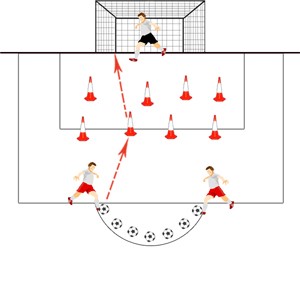
by Santosh | Jun 24, 2020 | Soccer, Sports
LEARNING OUTCOME
To improve Goalkeeping techniques
TEACHING CUES
- Keeper to be on toes all the time
- Anticipation & awareness
- Agility & flexibility
- Stance – bend the knees to lower the body, head and shoulders up straight. The legs are now loaded like springs for quicker reaction to low or high shots
- Decision making regarding the positioning of the hands / arms. Elbows tucked in with hands up or hand low.
ACTIVITY SET-UP AND PROCEDURE
EQUIPMENT:
Marked area, cones and balls
SET-UP:

ACTIVITY PROCEDURES:
- Play is set up as in diagram using one goal, one GK, two servers, 10 balls and cones randomly placed in or around the 6yd box.
- The aim of the drill is for the servers (midfielders or forwards) to shoot at the goal along the ground trying to hit a cone on the way, this will obviously deflect the ball in a different direction.
- Players shoot alternatively from either side giving the keeper time to set themselves in between each shot.
Progressions:
- Increase tempo of shots
- Increase / decrease distances between servers, cones and GK.
COOL DOWN/ CLOSURE
Review Skill/Activity, stretching, and questions.
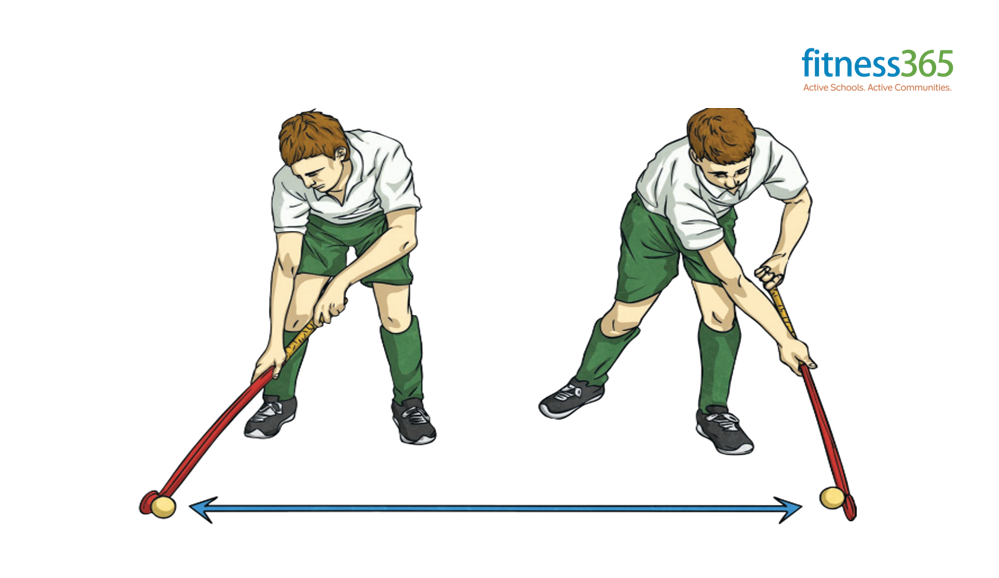
by Neetu | Jun 24, 2020 | Sports
Aim
- Move the ball while moving forward without losing the contact with the stick – keeping under control
- Follow directions by keeping control of equipment and body in order to keep safe and active.
Equipment Required
1 Hockey Stick, 1 ball per student, saucer cones, 4 Large cones for boundary
Play Area Set-Up
- Create boundaries for a large activity area with large cones.
- Line up cones to mark the starting point and endpoint of a dribble. Each student to line up behind the cone.
- Make lanes according to the number of students to allow Dribble with the ball in a straight line for 10m.
Activity Description
Grip & Stance
- Use basic grip
- The left-hand grip the stick at the top of the handle and turns it
- The right hand has a loose grip and allows the stick to be turned but also steers the direction of the stick
- Body position is low (knees bent leaning forward) with the arms extended in front of the body
- The stick is positioned with left hand close to the body and right hand out in front – comfortable stance
- The ball is in front of the body (approximately 1 stick length from the player’s ankle)
Movement:
- Move the ball from right to left – left to right across the body and roll the stick over the ball – no daylight between stick and ball
- Increase the distance of the Indian dribble – start ball, stick, and wrists outside the right side of the body and drag to outside their left
- Keep the ball in front of the body and look up during dribbling (vision)
- Transferring your weight to increase the length of the drag
- Push off on your right foot with a ball on forehand side – Push off a left foot with the ball on the reverse stick side
- Stick and ball on the right side – look at the time on your watch
TEACHING POINTS FOR INDIAN DRIBBLING
- Keep the ball close to your stick
- Carry the ball out in front & to the side of the right foot
- Bend at the knees–straight back–chin up
- Learn to look up while moving so that you can see what is happening around you and you won’t collide with anyone else
- Roll stick over the front of the ball to stop the ball moving forward & protect
- The only flat side of the stick can touch the ball
GAME: Red Light Green Light (with INDIAN DRIBBLE)
- It’s time to play Red Light, Green Light while we dribble our footballs. Cars use gasoline as fuel and some use electricity. Our bodies use Calories for fuel and we get Calories from food. When we’re physically active, we burn calories. It’s important that we eat healthy food in order to refuel our bodies. Who can give me some examples of healthy foods?
- Your goal is to dribble your football over the end line where I’m standing. I will be the traffic light first
- When I call out “Green Light,” you will start to dribble toward the other end line. When I call out “Red Light,” you have to stop and freeze immediately, keeping control of your football
- Any student who doesn’t stop on time must go back to the start.
- When you cross the end line that I’m standing on, you score a point and we’ll restart the game
Game : (Driver Test) or Rob the nest
- Four teams – each team behind a colored hoop – place hockey balls in the center of the square
- One player from each team runs out with their hook on the ground to collect one ball and dribbles back home – roll hook over the ball to stop it in their hoop
- Coach to call out the type of dribble to be used
- No hook on the ground or not dribbled back correctly that player will lose a turn
- The next player will run out and perform the same task – Play continues until no more hockey balls available
- Team with the most hockey balls wins
- Variations: 1. 1 player can rob the nest from another team once all hockey balls are out of the middle 2. All players can now rob –
- Question: Who is protecting their nest if all players are robbing their opponent’s nest? Play for one or two minutes extra when robbing the nests
Key points:
- Comfortable grip with hands in the right position.
- The ball is in front of the body and right of the feet
- Roll the hook over the ball to stop it
- Advise the teams to use the correct technique – not to cheat
- Advise the teams that are not winning to rob the nest of the team that is – therefore creating a fun atmosphere
- Teams can have one protector/goalkeeper for their nest







